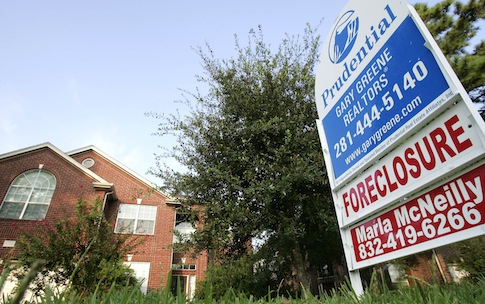Government housing agencies seeking to entice more low-income homebuyers to purchase mortgages are engaged in a price war that could leave taxpayers on the hook if another housing meltdown occurs, according to experts.
Both the Federal Housing Administration (FHA) and Fannie Mae and Freddie Mac, housing giants known as government-sponsored enterprises (GSEs), have announced programs in recent weeks that reduce lending standards and mortgage costs to attract low-income buyers.
President Barack Obama touted the FHA’s plan, which lowers annual insurance premiums on government-backed mortgages, earlier this month. That program follows Fannie and Freddie’s resumption in December of low down payment mortgage loans for eligible first-time homebuyers.
The timing of the two measures is not a coincidence, some experts say. Edward Pinto, former chief credit officer of Fannie Mae and a co-director of the American Enterprise Institute’s (AEI) International Center on Housing Risk, wrote in the Wall Street Journal on Wednesday that the federal agencies also competed for homebuyers in the decades before the 2008 housing crisis.
"Fannie’s goal in 1994 and today is to take market share from the FHA, the main competitor for loans it and Freddie Mac need to meet mandates set by Congress since 1992 to increase loans to low- and moderate-income homeowners," he said. "The weapons in this war are familiar—lower pricing and progressively looser credit as competing federal agencies fight over existing high-risk lending and seek to expand such lending."
As the agencies reduce prices in a tit-for-tat fashion to lure homebuyers, more risky mortgage loans are injected into the housing market. Critics say the purchase of such loans by Fannie and Freddie, spurred by federal housing mandates, contributed significantly to the 2008 crisis. The GSEs required a taxpayer bailout of $188 billion to stay afloat after 2008.
Fannie and Freddie operate by buying mortgage loans from lenders, packaging them into securities, and then selling those securities to investors with backing from taxpayers. The FHA, by contrast, offers mortgage insurance on loans by certain approved lenders. In 2013, the agency drew $1.7 billion from the Treasury Department to cover losses on bad loans.
Fannie and Freddie, along with the FHA, underwrite a majority of loans in the housing market.
Mel Watt, director of the Federal Housing Finance Agency (FHFA)—which oversees the GSEs—said during a congressional hearing on Tuesday that his agency would decide on the "guarantee fees" that Fannie and Freddie charge lenders by the end of March.
If the fees—which account for the risk Fannie and Freddie assume by buying the mortgage loans—are reduced, it could be another sign that the GSEs will lower prices further to compete with FHA and attract homebuyers.
Another concern about the brewing price war between Fannie and Freddie and the FHA is their lack of capital. Under a 2012 agreement with Treasury, Fannie and Freddie must hand over all of their profits to the government and cannot retain capital. The FHA will not reach its required minimum capital level of 2 percent until at least 2016. Both agencies could thus leave taxpayers exposed if their loans default, and there is no capital to absorb the losses.
"Mortgage price wars between government agencies are particularly dangerous, since access to low-cost capital and minimal capital requirements gives them the ability to continue for many years—all at great risk to the taxpayers," Pinto said. "Government agencies also charge low-risk consumers more than necessary to cover the risk of default, using the overage to lower fees on loans to high-risk consumers."
Homes have become less affordable since 2009, hurting middle-class homebuyers who receive smaller subsidies from the government than low-income purchasers. According to the urban planning site Demographia, the share of U.S. housing markets that are affordable has declined from 56 percent in 2009 to 36 percent last year.
AEI’s International Center on Housing Risk said in a briefing released Monday that there are not enough low-risk loans in the mortgage market to ensure "long-run market stability."
